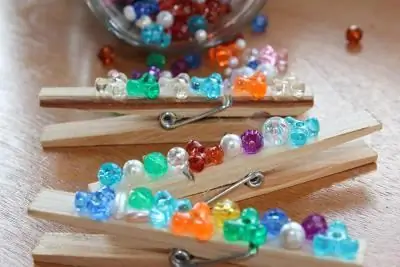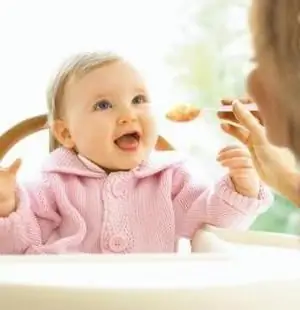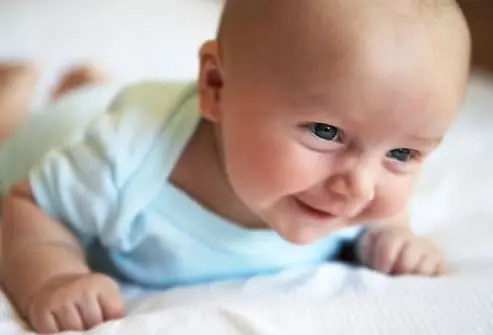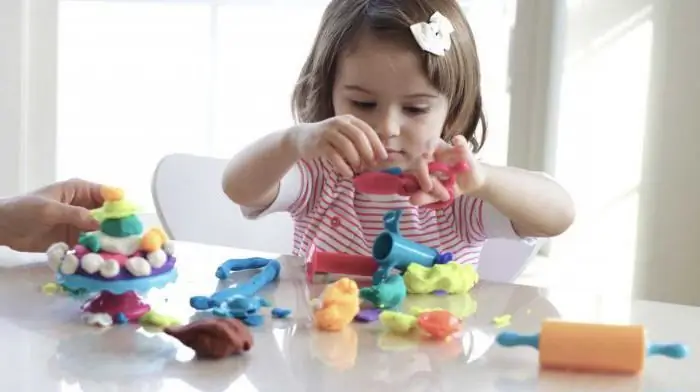2025 Author: Priscilla Miln | [email protected]. Last modified: 2025-01-22 17:55:15
Many modern mothers and fathers have already become familiar with the concept of "fine motor skills of hands". Trying to positively influence the development of the child, parents stubbornly slip sorters and finger labyrinths to the baby, and with older children they draw and sculpt all day long.
But how do you know if the actions taken are correct? Does the degree of load correspond to the age of the baby and do the exercises bring the desired effect? To answer these and other questions, you should take a closer look at the topic of developing fine motor skills.

General concept
Motor skills are a set of body movements performed under the control of the body's psychological reactions. The motor processes that a person owns give an idea of the level of development of his coordination and intelligence.
Psychologists classify physical activity, highlighting several of its types:
- General, or large, motor skills are responsible for the movements of a group of muscles. An example of such an activity is running or squatting.
- Fine motor skills - movements of the hand or fingers. Developed motor reactions of the hands help us lace up our shoes or lock the door with a key. Fine motor skills include actions in which it is necessary to combine the movements of the eyes and hands, as in drawing, for example.
- Articulatory motility is the ability to coordinate the work of the speech apparatus, that is, to speak.

A bit of physiology
While researching issues of child psychology and pedagogy, scientists have come to stunning conclusions. It turns out that about a third of the cerebral cortex is responsible for the development of hand motor skills. In addition, this third is located as close as possible to the speech center. A comparison of these facts gave grounds to consider the motor activity of the hands and fingers responsible for human speech.
In this regard, the development of fine motor skills of the hands of a young child is one of the fundamental tasks in teaching speech skills. Of course, along with the improvement of articulatory activity. The results of many years of experience prove that the conclusions of scientists were correct.
In addition to the above dependence, fine motor skills have a direct impact on the formation of logic, thinking skills, strengthening memory, training observation, imagination and coordination. Children who are more proficient with their hands show perseverance and tire more slowly.

Fine Motor Development Calendar
At every age, a child is able to performsome action. New opportunities appear in him as the nervous system matures. Each new achievement appears due to the fact that the previous skill was successfully mastered, so the level of motor skills formation must be monitored.
- 0-4 months - the child is able to coordinate eye movements, tries to reach objects with his hands. If you manage to pick up a toy, then the squeezing of the hand occurs, rather, due to reflexes that fade away up to six months. The baby does not yet have dominant preferences that allow performing actions with a more “comfortable” hand, and they will not appear soon - he is still both “right-handed” and “left-handed”.
- 4 months - a year - the child's skills are actively improving, now he can shift objects from hand to hand, perform simple actions like turning pages. Now with two fingers the baby will be able to grab even a small bead.
- 1-2 years - the movements are more confident, now the child uses the index finger more actively. The first drawing skills appear - the baby displays dots and circles, and soon he will be able to draw a line on the sheet with a pencil. Now he is starting to prefer one hand over the other.
- 2-3 years old - hand motor skills allow you to hold scissors and even cut paper with them. The manner of drawing changes along with the way the pencil is held, and the first conscious figures appear on the sheet.
- 3-4 years old - the kid already draws confidently, knows how to cut the sheet along the drawn line. He has already decided on the dominant hand, but in the games he skillfully uses both. Soon the child will learn to hold a pen or pencil, just likean adult, so by the age of 4 he will be ready to learn writing skills.
- 4-5 years. Fine motor skills of hands in children of this age already resemble the movements of adults. Please note: while drawing or coloring, the child does not move the whole arm at once, but only with the brush. The movements are more refined, so cutting out an object from paper or decorating without going beyond the contours is no longer so difficult.
- 5-6 years. At this age, the preschooler's hands should be perfectly coordinated, the child already holds the pen with three fingers, draws small details, like an adult, knows how to use scissors. All the skills of the kid indicate that he will not experience difficulties in school.

Low motor development - what is the risk?
Inadequately formed motor skills of the hands impede not only the development of speech skills. Such a child may experience problems with memory, logic. If this is a preschooler, then he needs urgent help, because he will be absolutely not ready for school. Such a student will have difficulty concentrating, he will quickly get tired and will inevitably fall behind.
When and how to start exercising with a baby?
From birth, you can begin to pay attention to the development of the baby. Of course, a newborn is not interested in a sorter or a toy with lacing. But you can start putting rattles in his handle, let him touch the fabrics of different textures with his fingers, give the baby a massage of the handles.
The age at which activedevelopment of motor skills of the fingers, - 8 months. If until now this issue has not been given attention, now is the time to take some action.

Exercise
To arrange real classes with her own baby, mom does not need professional teaching skills. For exercises, the simplest items that can always be found in any home are suitable. The main principle on which the development of hand motor skills is built is “from large to small”. What does it mean?
- Start rolling plasticine balls with your child. Let the kid blind something. If he can do it, you can gradually move on to smaller and more complex details.
- You can just tear the paper. First into large pieces, then into small ones. The finer the details in the end, the higher the level of motor development in the child.
- You can string beads on a string with your baby, tie shoelaces, fasten buttons.

Passive gymnastics (massage)
A competent massage therapist is an excellent assistant in developing the child's coordination. An experienced specialist will help with the motor skills of the baby's hands. You can start classes already in the first 3-4 months of the child, while sessions can be held for 5 minutes up to several times a day.
Massage sessions are best entrusted to a professional, but if necessary, some exercises can be performed independently. So, the baby's hands need to be stroked for a minute, then slightly rubbed. Then producevibrating tapping fingers on the hands and palms. Another effective massage exercise is flexion and extension of the fingers, followed by massaging each.

Toys
Toys for motor skills are sold in large quantities in children's goods stores. They even come with instructions indicating the recommended age and a description of the game process. But you don't have to buy anything at all. You can play with any objects - almost any thing in the house is suitable for the development of motor skills (safe for the child).
A do-it-yourself board for the development of motor skills, or a Montessori board, is a great gift for a baby aged from one to 3 years. Dad can make such a toy. To do this, you need a sheet of plywood and the most dangerous items in the house: a socket with a plug, furniture fittings, switches, latches and other household items. The meaning of the toy lies in the child's knowledge of such things in their safe form. After getting acquainted with the socket on the stand, the baby will not become interested in the real one, and by feeling these objects with his fingers, he will develop finger motor skills.

If your beloved child is already 3 years old, then you can offer a game of Cinderella. To do this, various cereals or legumes are poured into the bag, and the child is given the task to sort through everything.
Why not play Guessing Game? You can blindfold the baby and put household items into his hands in turn - let him guess them.
In addition,the child will approve of mosaic games, finger theater, joint applications. Helping your beloved child to improve himself is not at all difficult, the main thing is to apply your own imagination a little.
Recommended:
What should a baby be able to do at 1 month old? Skills and features of development

Modern mothers begin to engage in the development of the baby almost immediately after his discharge from the hospital. Of course, all parents want their child to at least meet the standards from the development calendar, and even better - to get ahead of them. The list of what a child should be able to do at 1 month is small. However, it is worth studying it and carefully looking at the newborn in order to prevent possible pathologies
Activities that help to activate the development of fine motor skills in preschool children

The development of fine motor skills in preschool children is always in the focus of attention of educators and parents, because the child's oral speech begins to form only when the accuracy of the movement of his fingers reaches the required level. The relationship between these skills is undeniable
Children's autumn crafts for kindergarten: the development of perseverance, fine motor skills and imagination

There is an opinion that children's autumn crafts for kindergarten and their production are focused only on a certain time. In fact, all materials that are collected in the corresponding season can be used in any other period
Child development at 11 months: new skills. Child 11 months: development, nutrition

Your baby is preparing for the first anniversary in his life - he is already 11 months old! He learns to perform new actions, slowly begins to speak, tries to move independently, eat. At this time, the child learns a lot of new and unknown things. What should a baby be able to do in his 11 months and how to care for him?
How to develop a baby at 3 months? Child development at 3 months: skills and abilities. Physical development of a three-month-old baby

The question of how to develop a child at 3 months is asked by many parents. The increased interest in this topic at this time is especially relevant, because the baby is finally starting to show emotions and is aware of his physical strength

